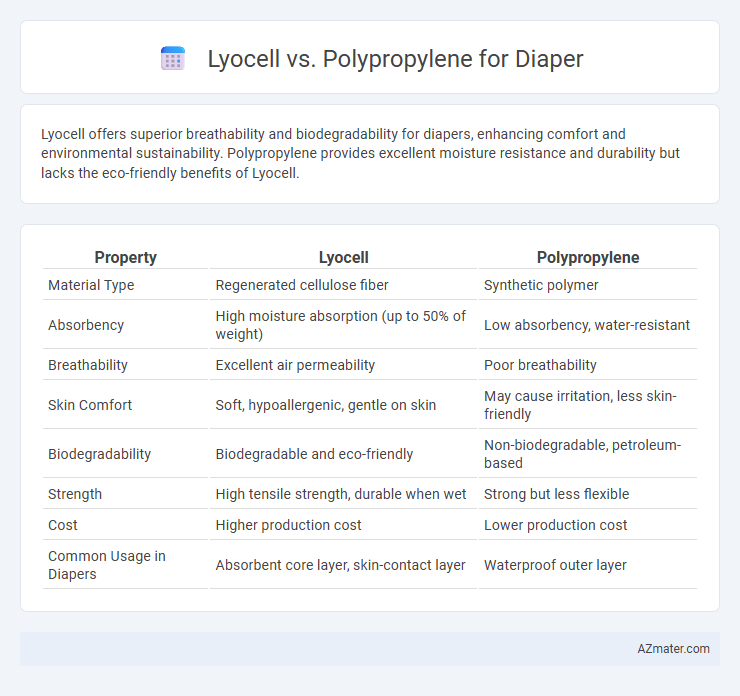Lyocell offers superior breathability and biodegradability for diapers, enhancing comfort and environmental sustainability. Polypropylene provides excellent moisture resistance and durability but lacks the eco-friendly benefits of Lyocell.
Table of Comparison
| Property | Lyocell | Polypropylene |
|---|---|---|
| Material Type | Regenerated cellulose fiber | Synthetic polymer |
| Absorbency | High moisture absorption (up to 50% of weight) | Low absorbency, water-resistant |
| Breathability | Excellent air permeability | Poor breathability |
| Skin Comfort | Soft, hypoallergenic, gentle on skin | May cause irritation, less skin-friendly |
| Biodegradability | Biodegradable and eco-friendly | Non-biodegradable, petroleum-based |
| Strength | High tensile strength, durable when wet | Strong but less flexible |
| Cost | Higher production cost | Lower production cost |
| Common Usage in Diapers | Absorbent core layer, skin-contact layer | Waterproof outer layer |
Introduction to Lyocell and Polypropylene in Diapers
Lyocell, a sustainable fiber made from wood pulp, offers excellent moisture absorption and breathability, making it ideal for diaper inner layers. Polypropylene, a synthetic polymer, provides a lightweight, waterproof barrier in diaper outer layers, ensuring leak protection and durability. Combining Lyocell's natural comfort with polypropylene's strength enhances overall diaper performance and skin health.
Material Composition: Lyocell vs Polypropylene
Lyocell is a biodegradable fiber made from sustainably sourced wood pulp through a closed-loop process, offering exceptional moisture absorption and breathability ideal for diapers. Polypropylene is a synthetic polymer derived from petroleum, known for its hydrophobic properties, durability, and cost-effectiveness but lacks natural moisture-wicking abilities. The choice between Lyocell and Polypropylene in diaper manufacturing significantly impacts environmental sustainability, comfort, and performance due to their distinct material compositions.
Absorbency and Liquid Management
Lyocell fibers offer superior absorbency and moisture-wicking properties compared to polypropylene, making them highly effective for diaper applications where keeping skin dry is critical. Polypropylene provides a strong, hydrophobic barrier that prevents liquid leakage but does not absorb fluid, relying instead on underlying absorbent layers. Diapers combining Lyocell's high liquid retention with polypropylene's leak resistance optimize both absorbency and liquid management for enhanced comfort and protection.
Breathability and Comfort for Babies
Lyocell offers superior breathability compared to polypropylene due to its natural cellulose fibers that wick moisture away, keeping a baby's skin dry and reducing irritation. Its softness enhances comfort, providing a gentle and breathable barrier essential for sensitive infant skin. Polypropylene, while effective as a waterproof layer, lacks the same moisture management and softness, potentially leading to discomfort during extended wear.
Environmental Impact and Biodegradability
Lyocell, derived from sustainably sourced wood pulp, offers superior environmental benefits compared to polypropylene due to its biodegradable nature and low-impact production process, which uses non-toxic solvents and minimal water. Polypropylene, a petroleum-based synthetic polymer, poses environmental challenges because it is non-biodegradable and contributes to microplastic pollution when disposed of improperly. Choosing Lyocell in diaper manufacturing significantly reduces landfill waste and supports circular economy principles through its compostability and reduced carbon footprint.
Skin Safety and Allergenicity
Lyocell offers superior skin safety for diapers due to its natural, biodegradable fibers that are soft, breathable, and hypoallergenic, significantly reducing the risk of irritation and allergic reactions. Polypropylene, a synthetic polymer, is less breathable and may trap moisture, increasing the chances of skin irritation and potential allergen exposure. Choosing Lyocell enhances diaper comfort by minimizing contact dermatitis and supporting sensitive skin health.
Cost Comparison in Diaper Manufacturing
Lyocell fibers in diaper manufacturing offer superior biodegradability and moisture absorption but come with higher raw material costs compared to polypropylene, which is cheaper and widely used for its strength and water resistance. The production cost of Lyocell is influenced by its environmentally-friendly closed-loop process, raising expenses relative to polypropylene's petrochemical-based, cost-efficient mass production. Manufacturers must balance Lyocell's premium pricing with its sustainability benefits while polypropylene remains the economical choice for large-scale diaper production.
Durability and Performance in Real Use
Lyocell exhibits superior durability in diapers due to its natural fibers' strength and moisture-wicking capabilities, ensuring sustained performance during extended wear. In contrast, polypropylene offers excellent water resistance and quick-drying properties but may degrade faster under repeated stress and washing. Real-use scenarios demonstrate Lyocell's enhanced comfort and breathability, while polypropylene provides effective barrier protection with less flexibility.
Market Trends and Consumer Preferences
Lyocell, a sustainable fiber known for its softness and biodegradability, is gaining traction in the diaper market as consumers increasingly prioritize eco-friendly materials and skin sensitivity. Polypropylene remains popular due to its cost-effectiveness, durability, and moisture-wicking properties, maintaining strong demand in mass-market diapers. Current market trends indicate a growing shift towards natural fibers like Lyocell driven by rising environmental awareness and regulatory pressure on single-use plastics.
Choosing the Best Material for Modern Diapers
Lyocell, a biodegradable fiber made from eucalyptus pulp, offers superior absorbency, breathability, and softness, making it an eco-friendly choice for modern diapers that prioritize comfort and sustainability. Polypropylene, a synthetic polymer, provides excellent moisture barrier properties and durability but lacks biodegradability and may cause skin irritation in sensitive babies. Selecting the best material for modern diapers depends on balancing environmental impact, moisture management, and skin health, with Lyocell increasingly favored for its natural origin and high performance.

Infographic: Lyocell vs Polypropylene for Diaper
 azmater.com
azmater.com